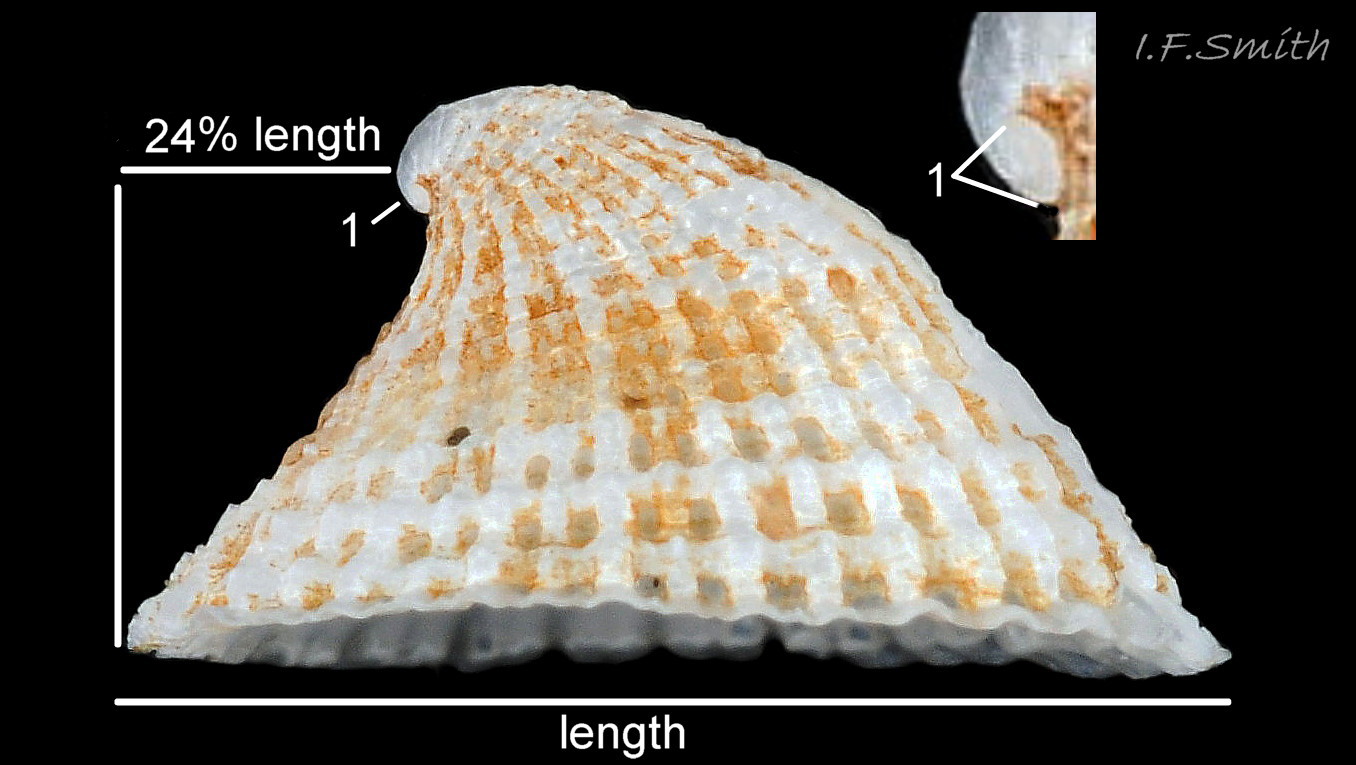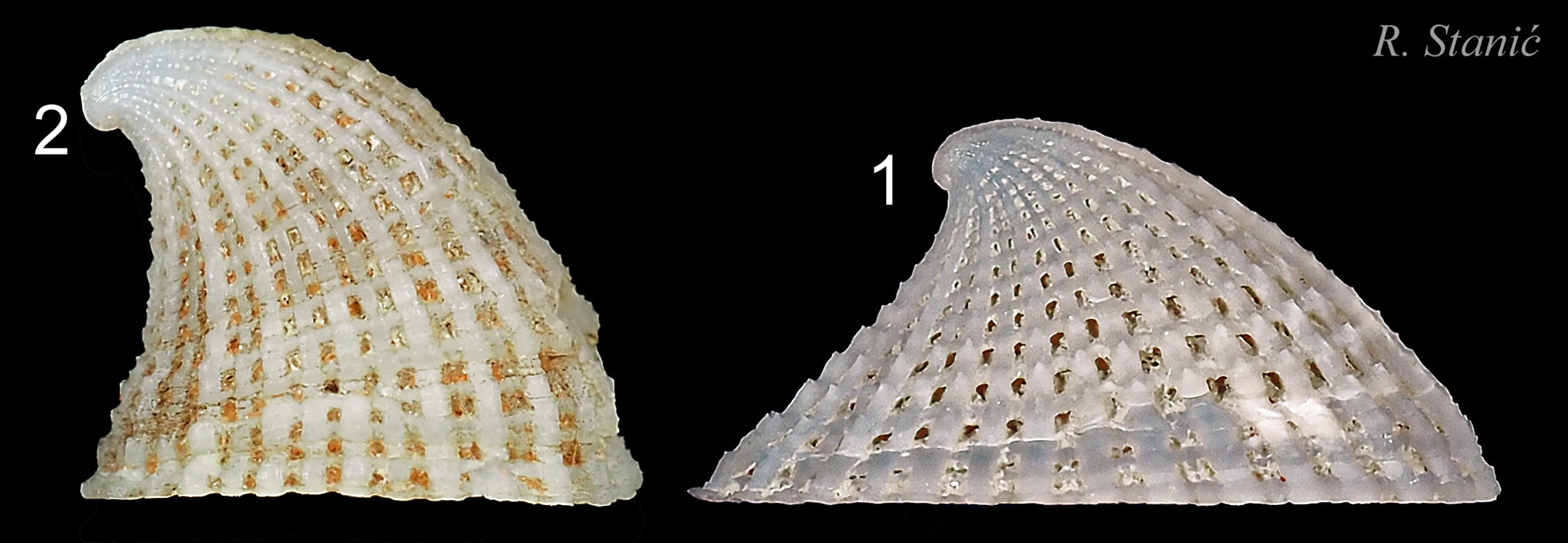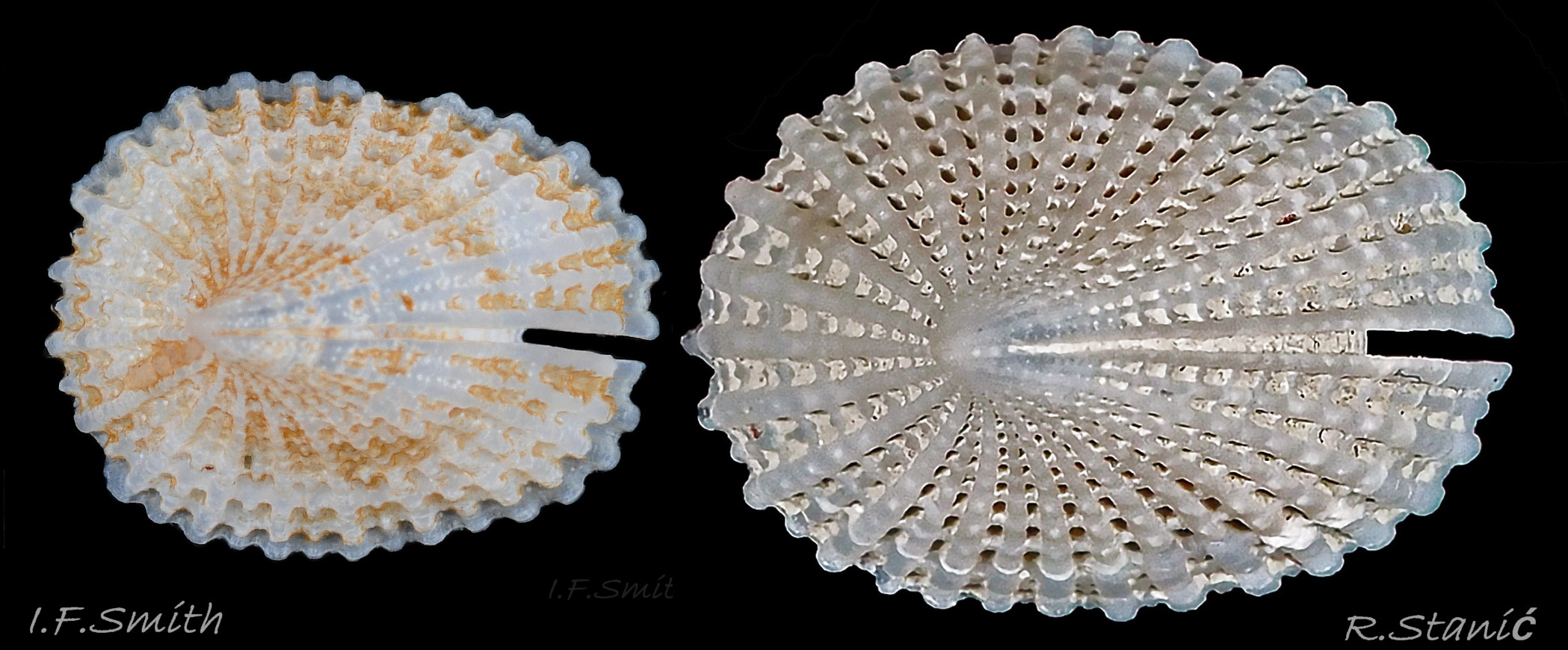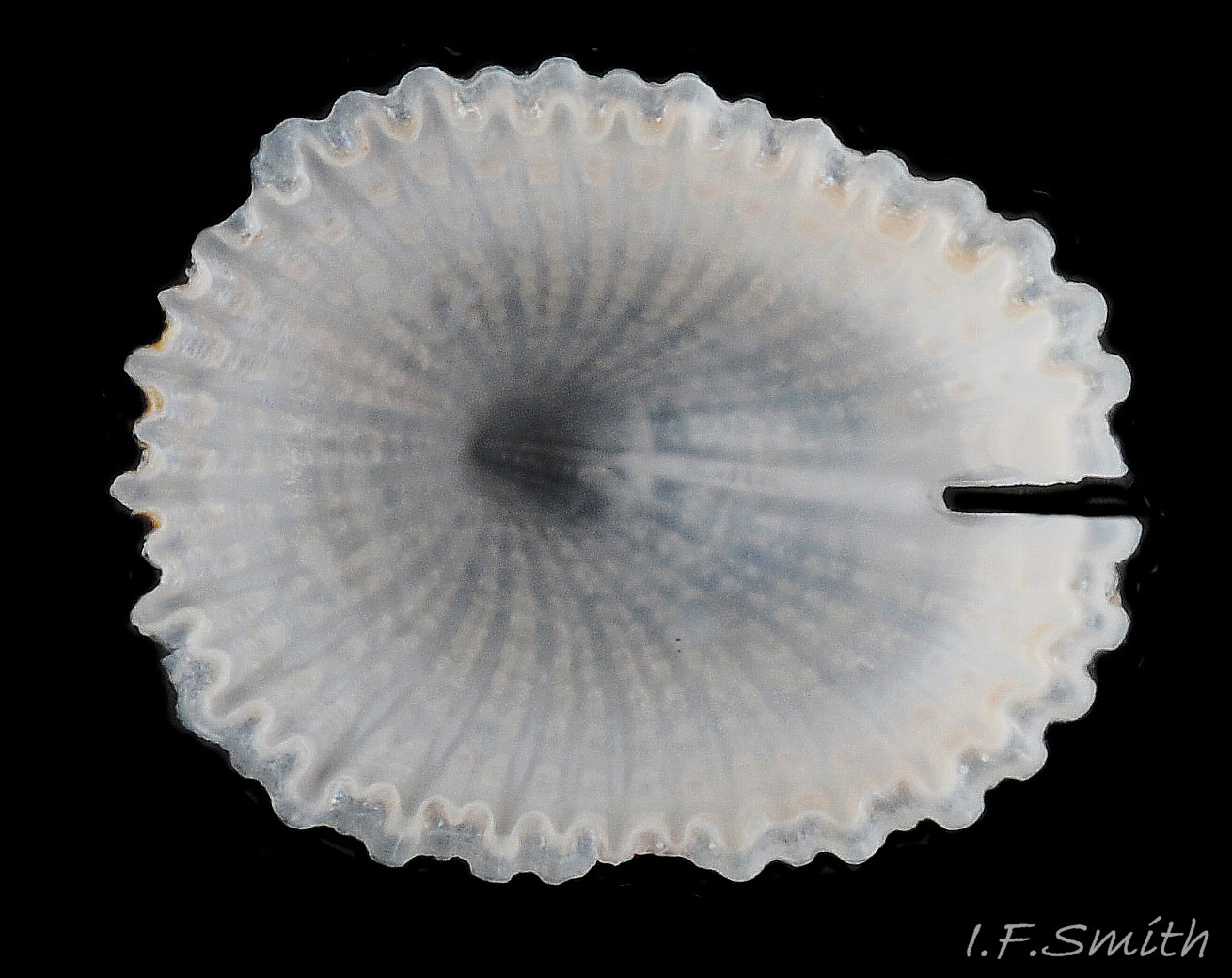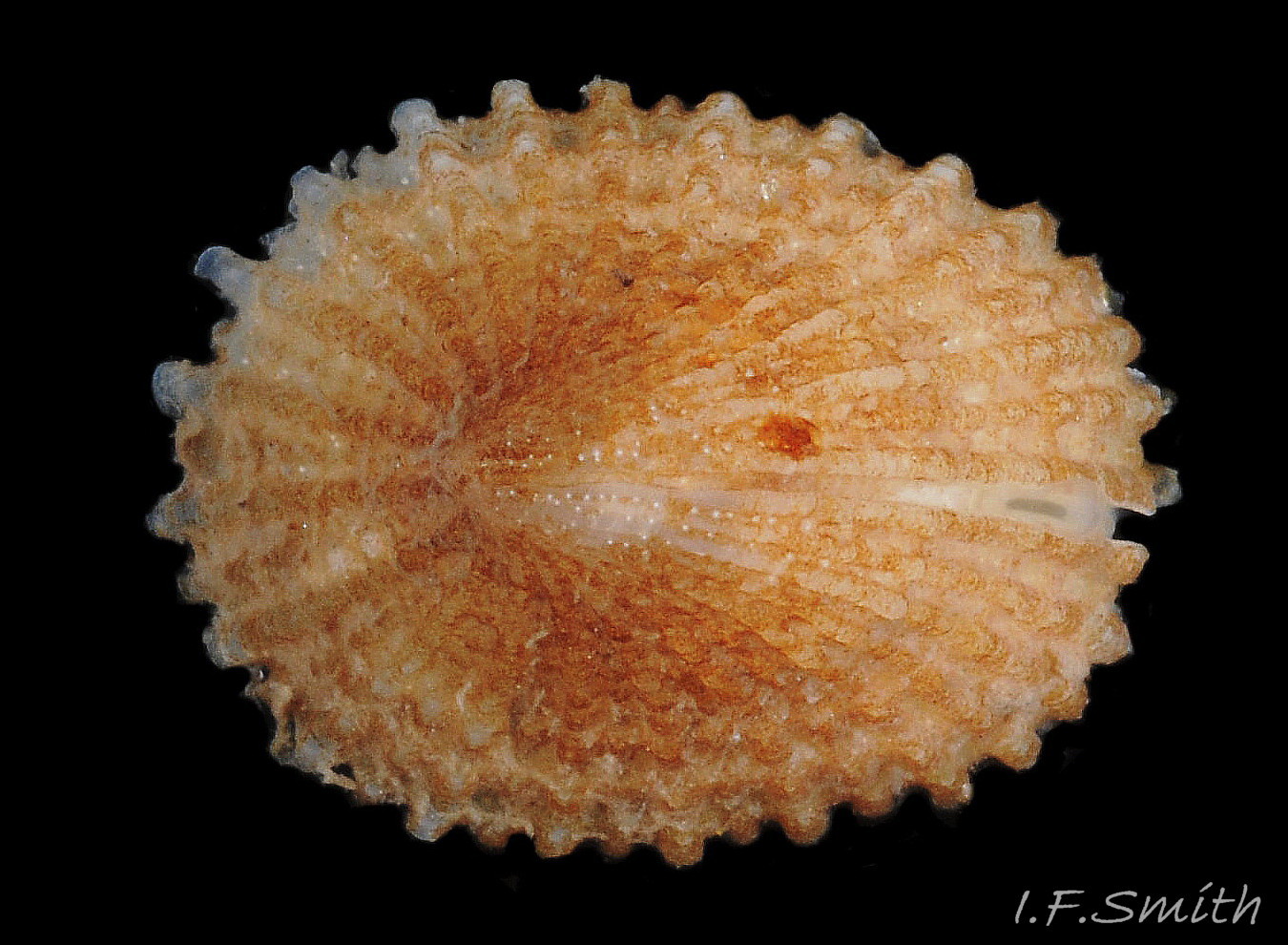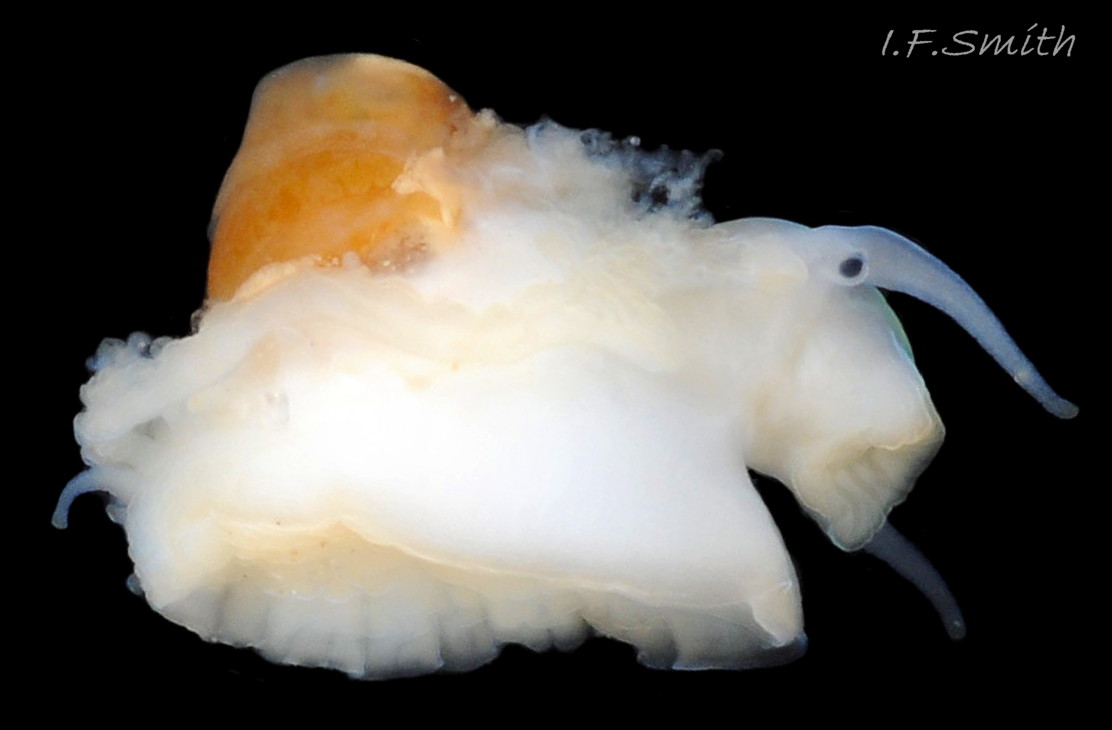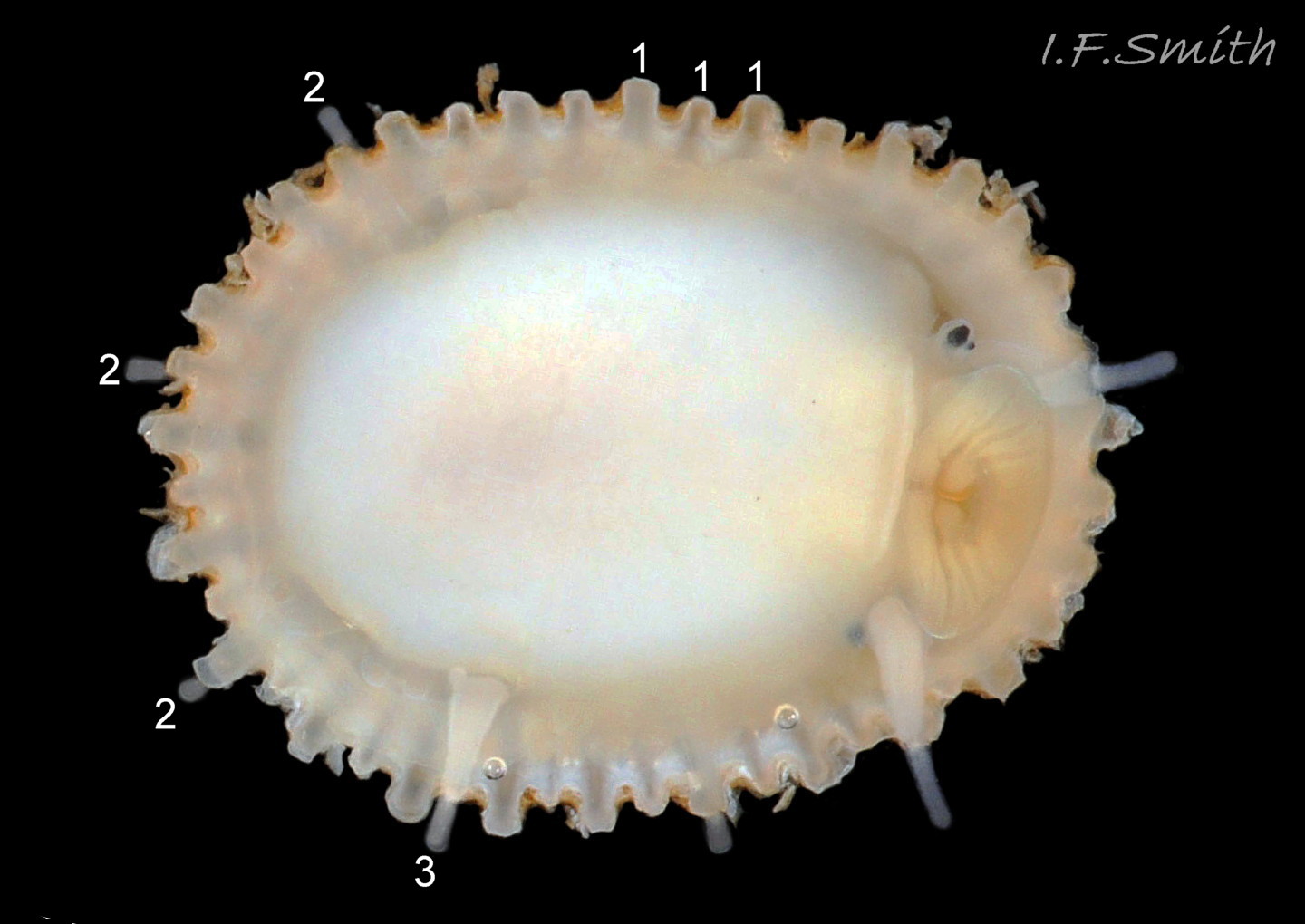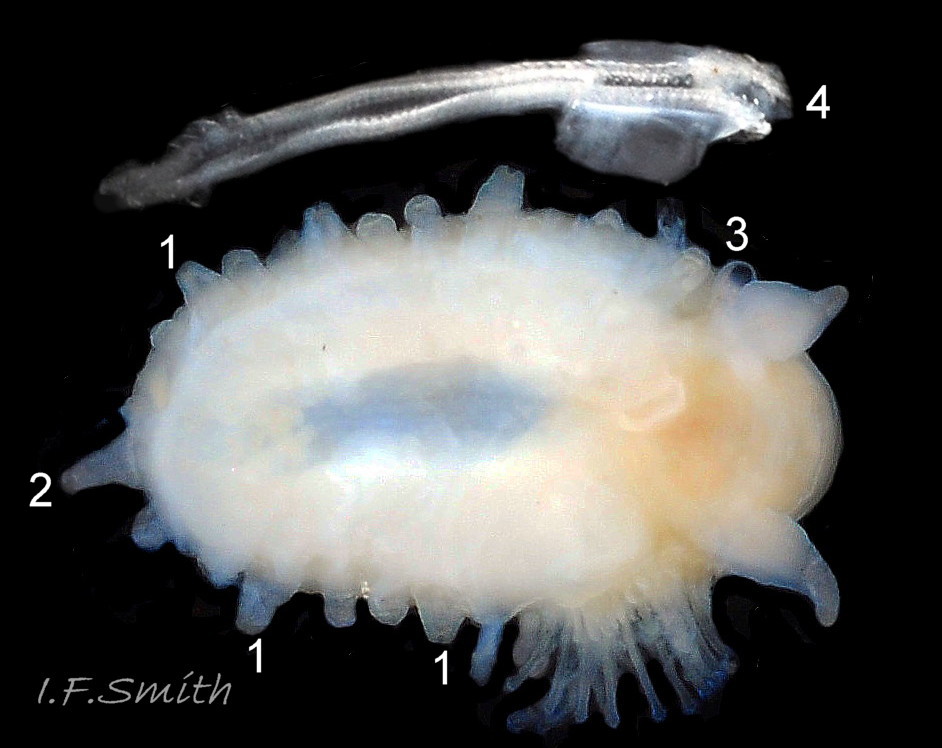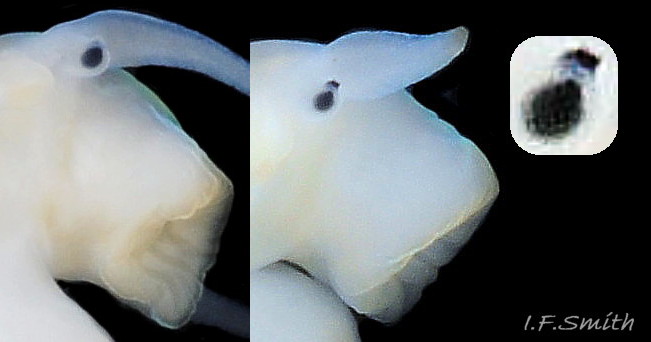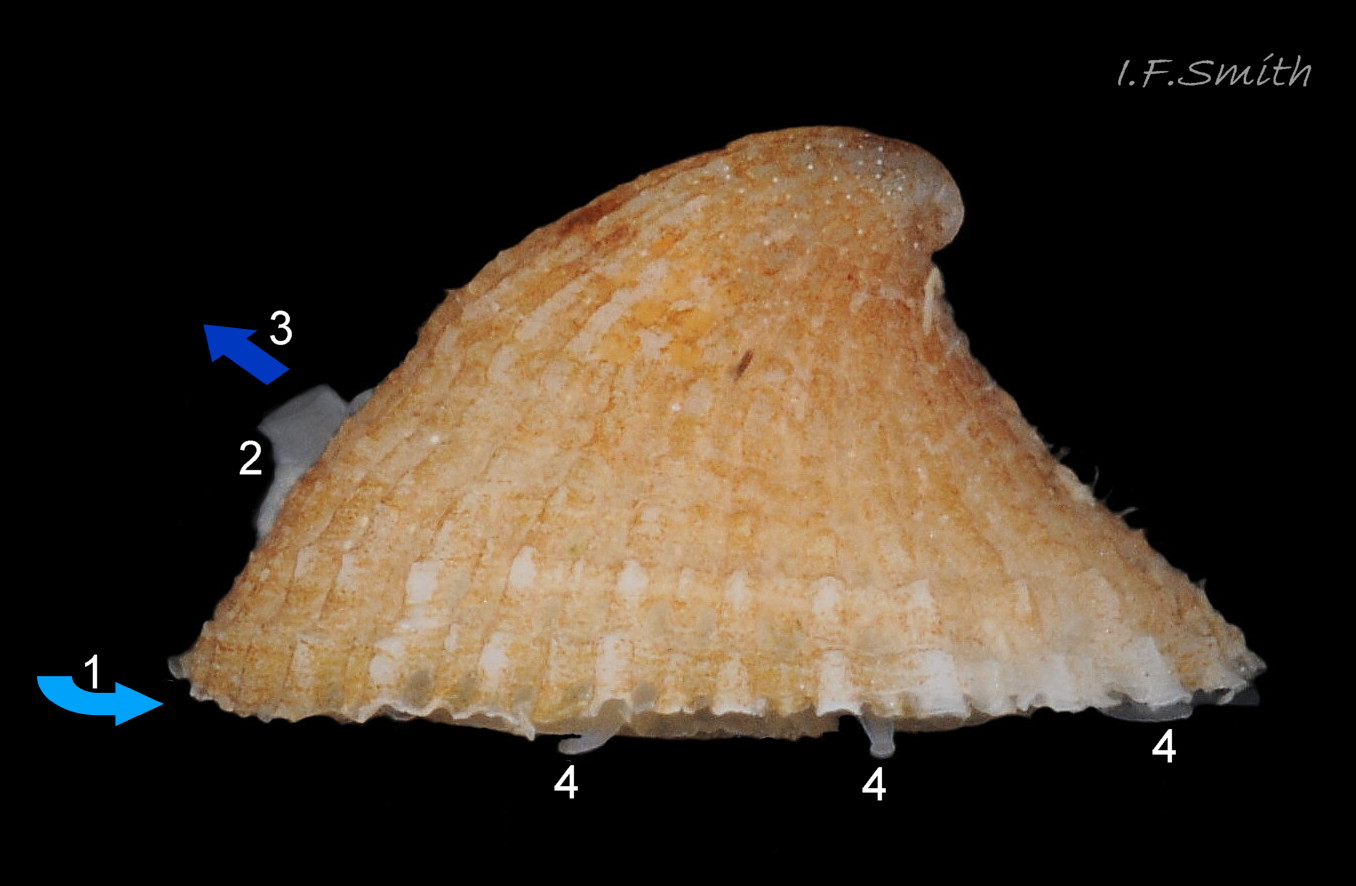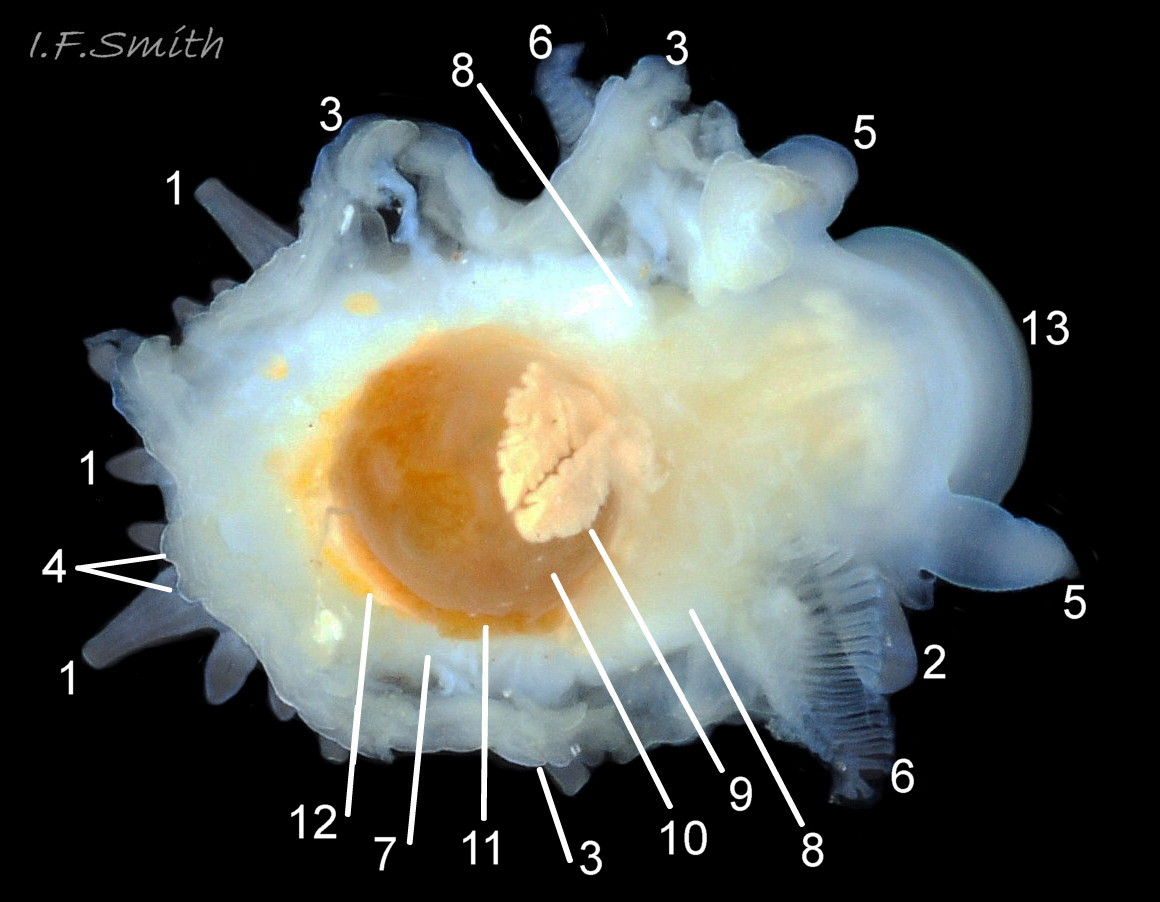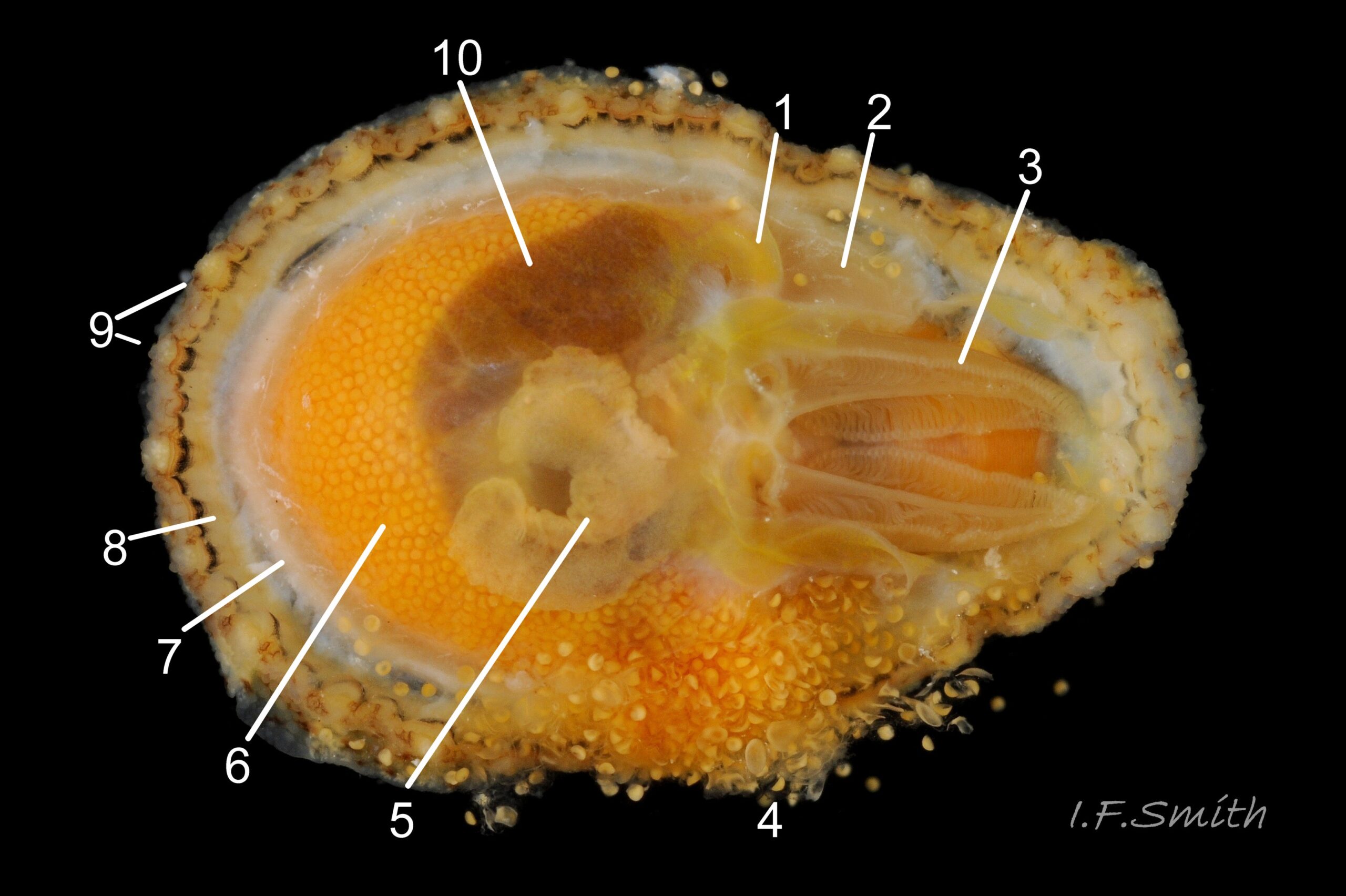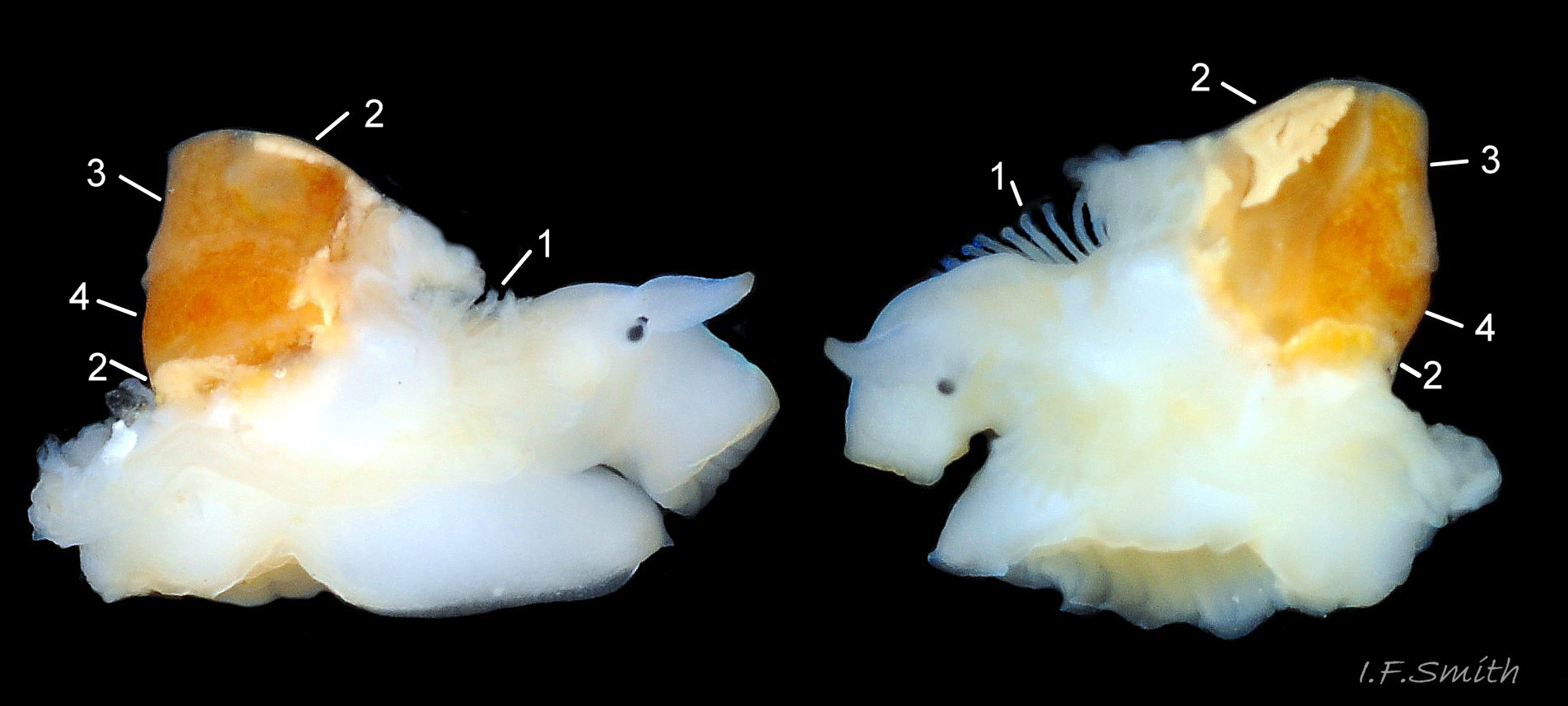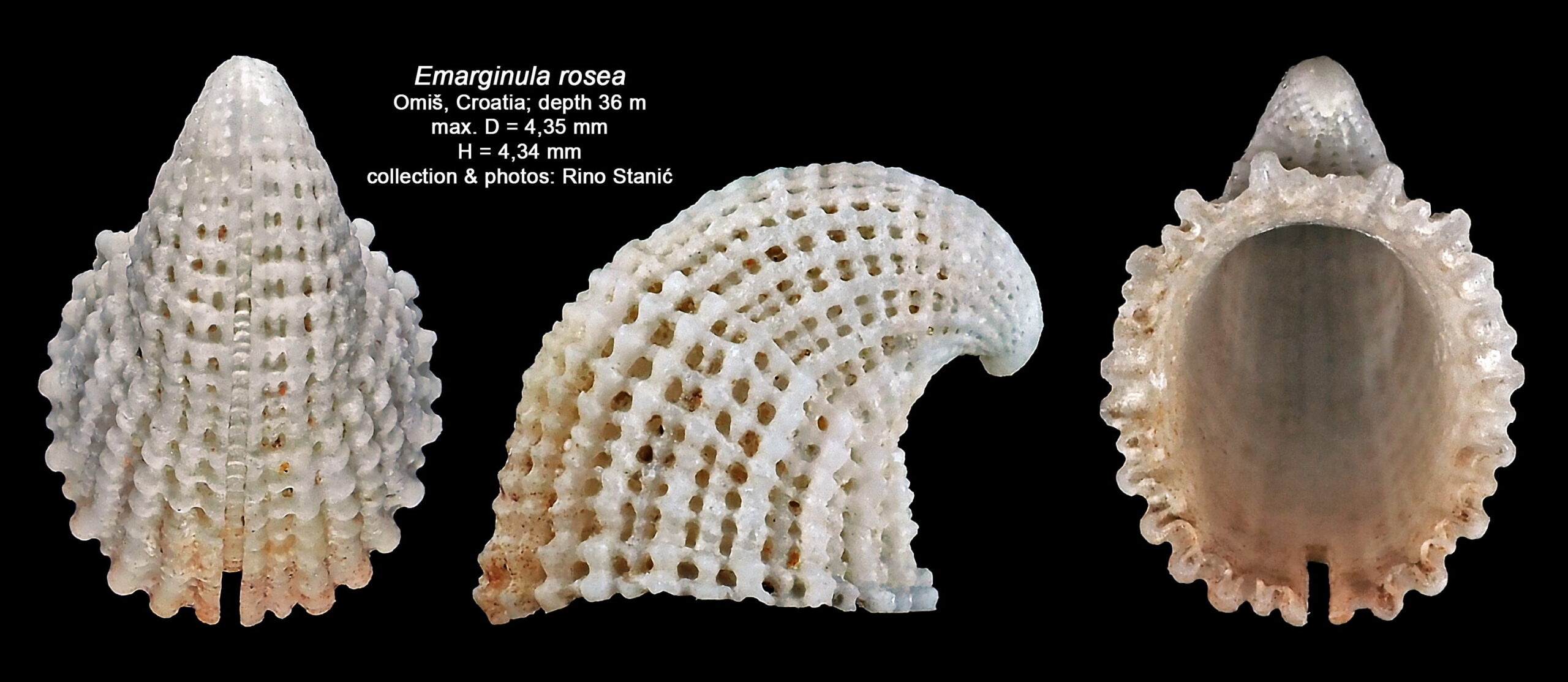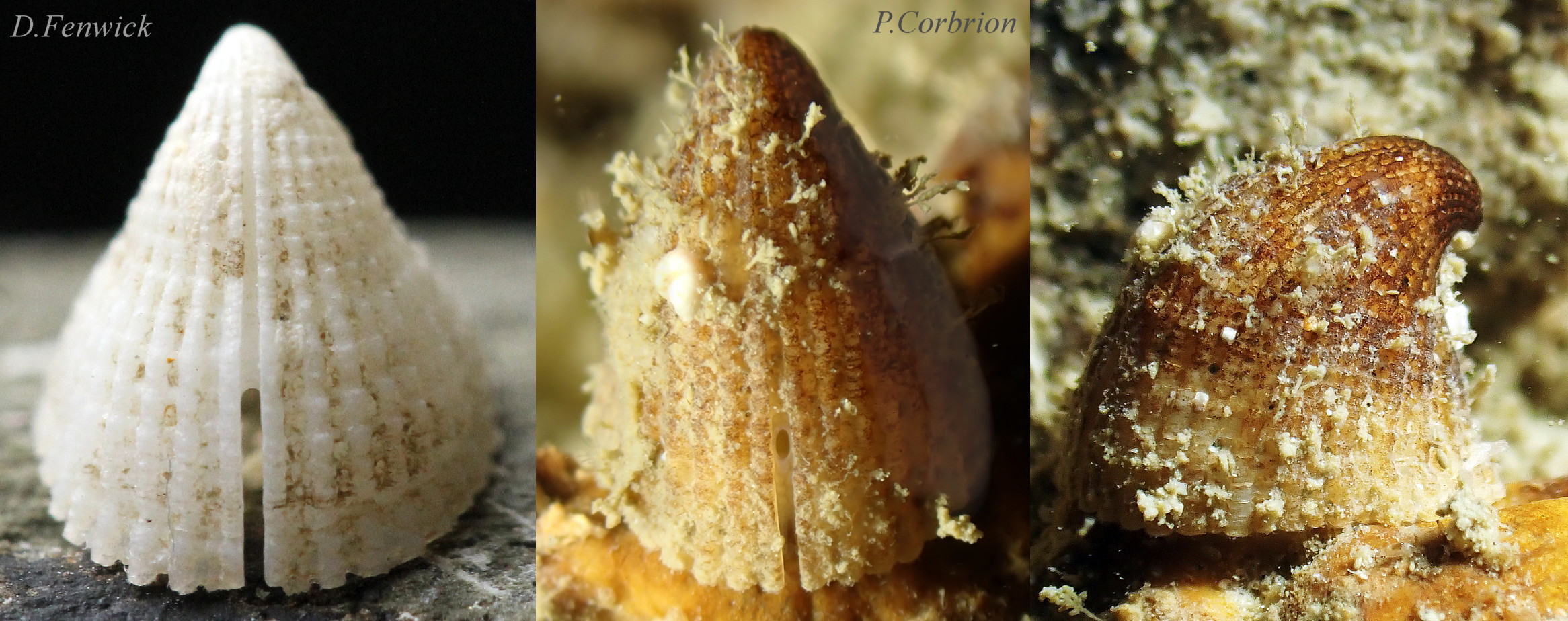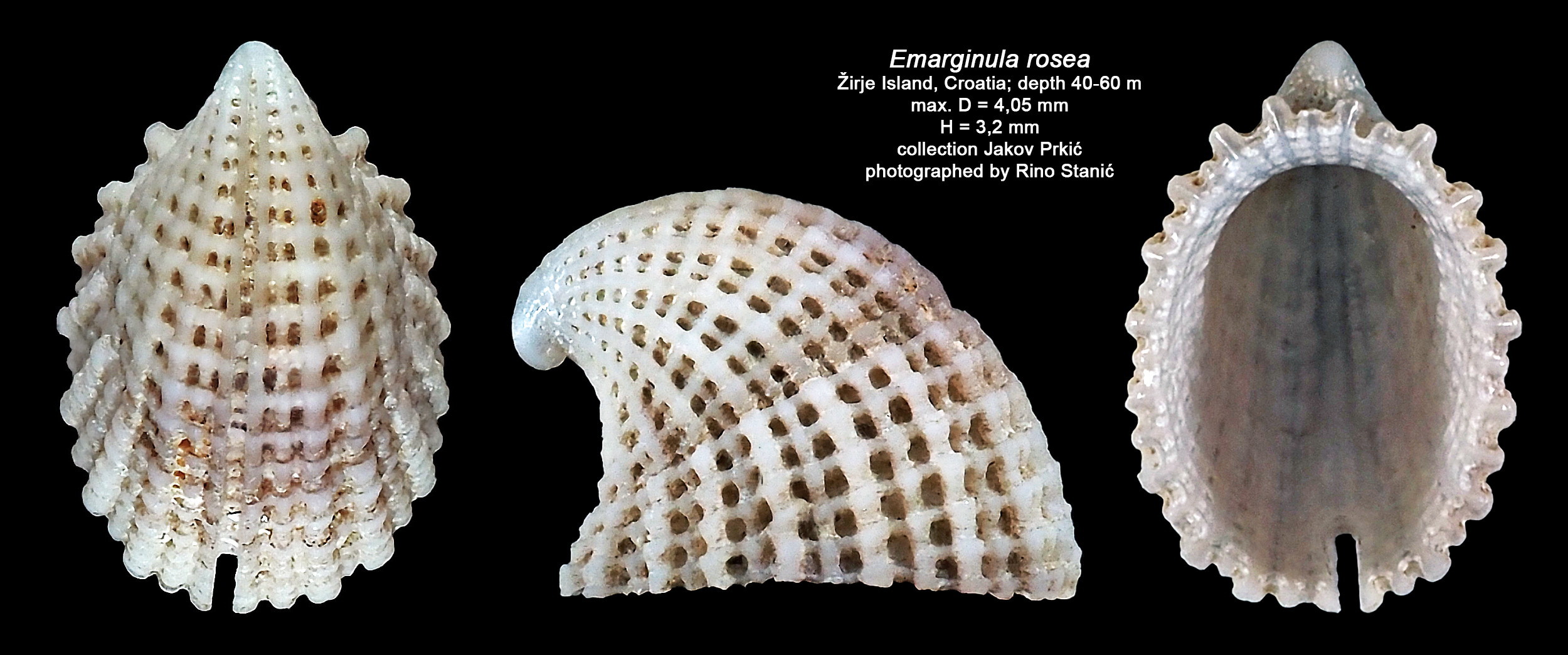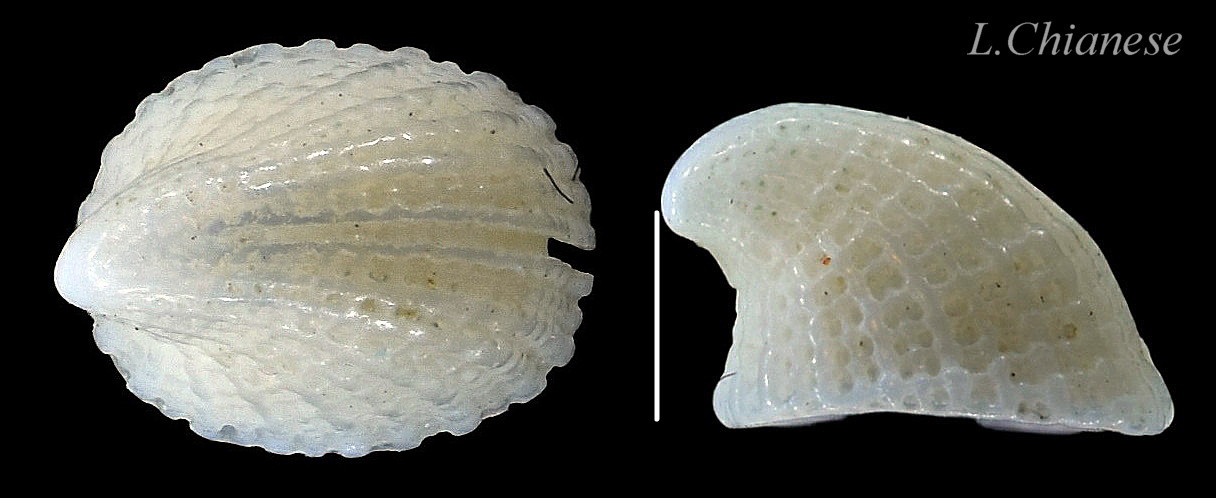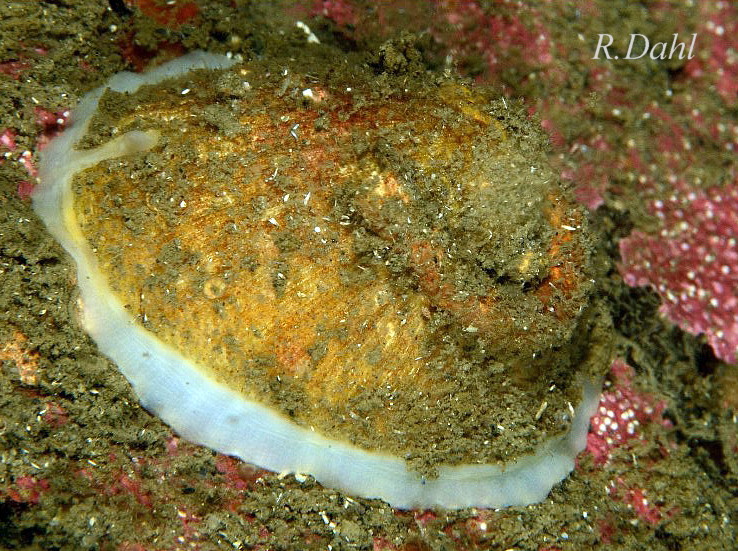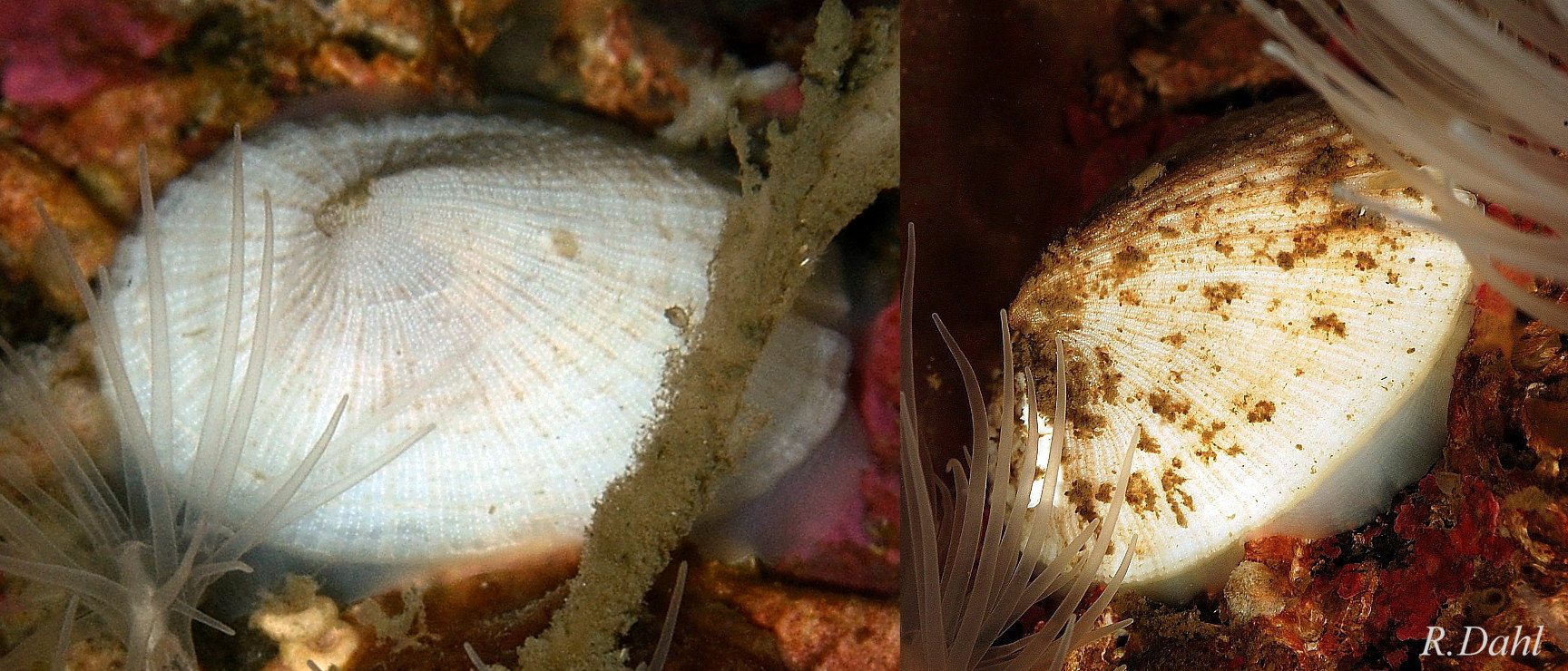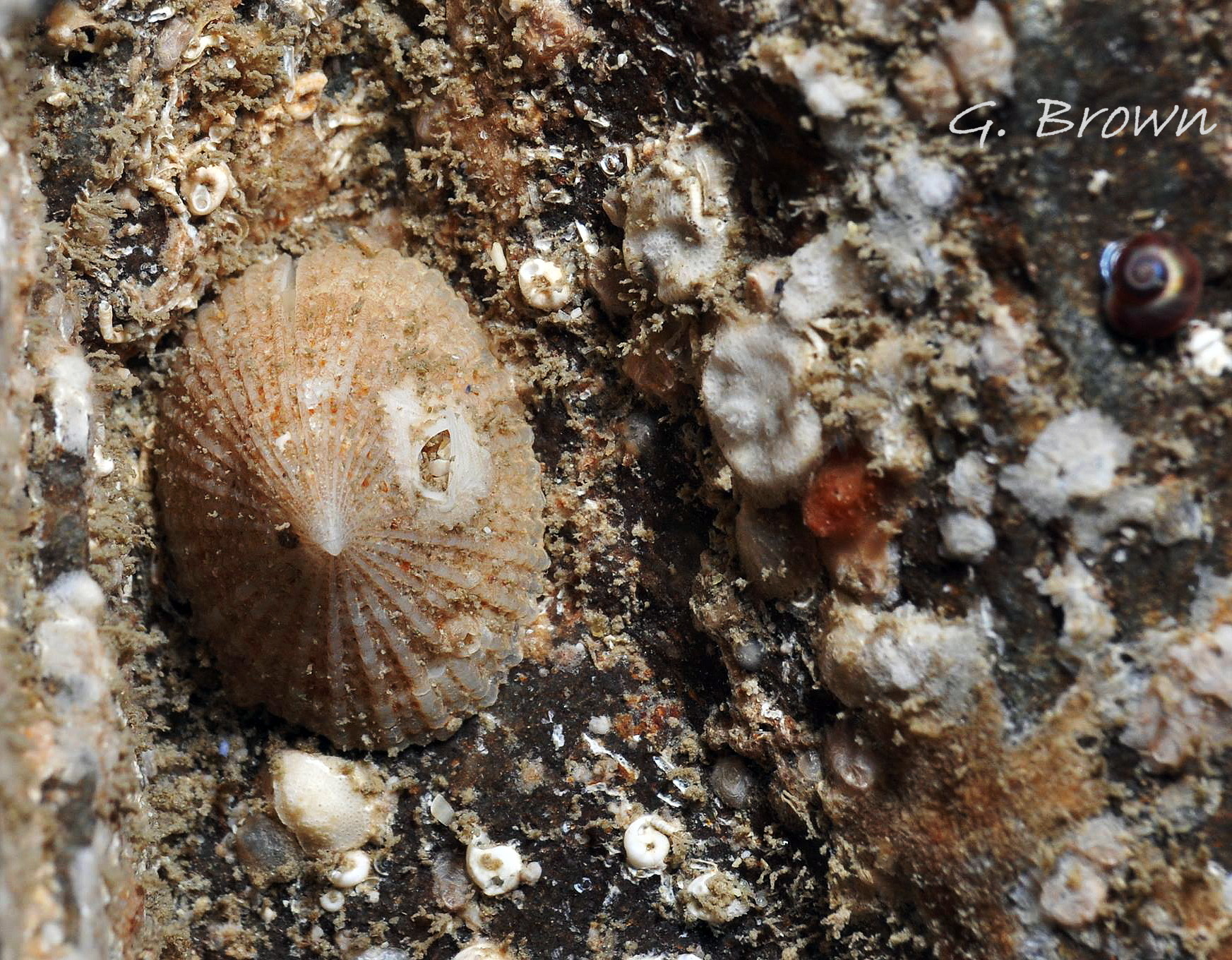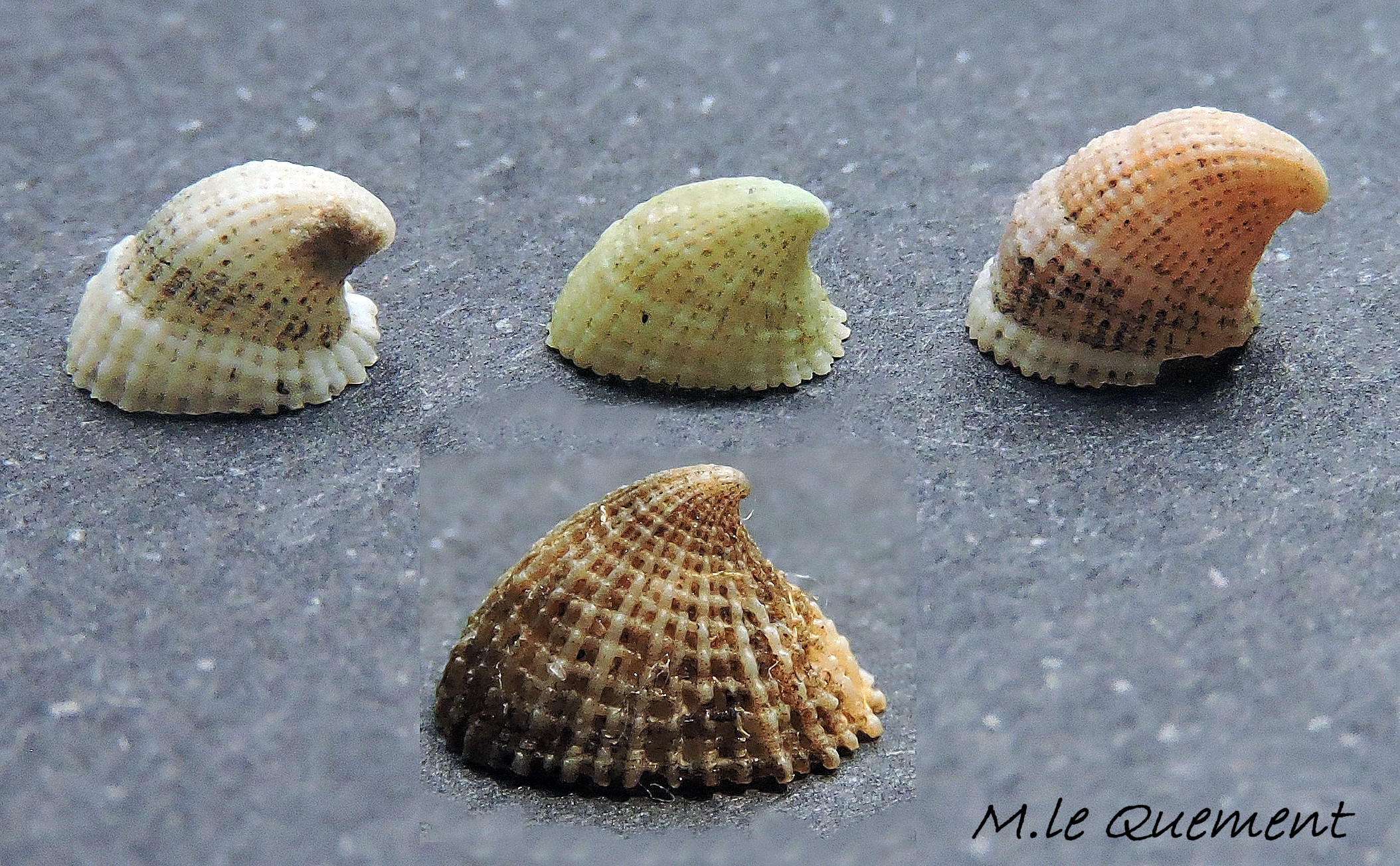Click image to enlarge with full caption. Main text below slider.
Emarginula fissura (Linnaeus, 1758)
PDF available at www.researchgate.net/publication/367655295_Emarginula_fis…
Synonyms: Patella fissura Linnaeus, 1758; Emarginula conica Lamarck, 1801; Emarginula reticulata J. Sowerby, 1813;
Current taxonomy: World Register of Marine Species (WoRMS)
www.marinespecies.org/aphia.php?p=taxdetails&id=139959
Vernacular names: Slit limpet (English); Brenigen hollt (Welsh); Slidset albueskæ (Danish); Geruite napslak (Dutch); Schlitzschnecke, Geschlitzte Napfschnecke (German); hjelmsnegl (Norwegian); slitsskalsnäcka (Swedish); emarginule (French):
GLOSSARY below.
Shell Description
The shell is usually up to 10 mm long, 8 mm wide and 6 mm high (Graham, 1988); rare extreme maxima are L. 18 mm W. 13 mm and H. 8 mm (Nordsieck, 1974 in Piani, 1984). Most found intertidally are smaller. It is shaped like a Phrygian cap with the pointed crown curved backwards to usually about 25% of shell-length from the posterior 01 Emarginula fissura but sometimes the apex curves back nearly as far as the posterior margin 02 Emarginula fissura . The protoconch is a minute spiral of two whorls on the right posterior of the apex 01 Emarginula fissura . The height is usually from 50% to 70% of the length, but scarce exceptions are as low as 48% or as high as 86% of the length 02 Emarginula fissura & 03 Emarginula fissura COMPARE E. rosea & E. crassa .
The exterior surface has about 35 radial ridges crossed by about 20 less prominent, narrower, concentric ridges which are most distinct where they cross the spaces between the radial ridges and form small tubercles where they cross the radial ridges 04 Emarginula fissura . The intersecting ridges form a reticulated pattern; hence the synonym, E. reticulata.
The aperture is an oval with a slightly wider posterior, and its rim is crenulated by the ends of the exterior ridges 05 Emarginula fissura . The anterior of the shell has a marginal slit with a recessed slit-band of shell material filling the slit of earlier growth stages 04 Emarginula fissura . The anterior profile is convex and the posterior concave 01 Emarginula fissura . Externally the shell is white or greyish white, but live specimens are often stained brownish 06 Emarginula fissura . Early growth near the centre of the shell may have minute white, glistening dots arranged in rows along the ridges 06 Emarginula fissura. They are the ends of caeca penetrating the shell, which contain and are formed by extensions of the mantle epithelium. Their function is unknown; no evidence has been found of it being sensory or protective (Reindl & Haszprunar, 1994). The interior is nacreous white, often with the exterior ridges showing through 05 Emarginula fissura .
Body description
The flesh is entirely white 07 Emarginula fissura . The head has a broad, bluntly truncated snout ending in an opening with a pleated interior 10 Emarginula fissura which can expand into a large mouth 08 Emarginula fissura . When extended, the cephalic tentacles have a stout base and taper to a slender distal tip 07 Emarginula fissura . A short stalk bearing a black eye extends from the outer side of the base of each tentacle 09 Emarginula fissura . There is often an aberrant extra eye. The pear-shaped black pigment of the eye can be discerned through the side of the translucent stalk but only the pinhole narrow end is open to the water 10 Emarginula fissura .
The mantle is thin and almost transparent over the visceral mass. Its thickened edge extends with small sensory papillae 12 Emarginula fissura to the ends of the furrows on the reverse of the external ridges of the shell 08 Emarginula fissura . The anterior of the mantle skirt has a cleft which is replicated as a slit in the shell above. The edges of the mantle protrude through the shell-slit as a short exhalent siphon 06 Emarginula fissura & fig.11 11 Emarginula fissura leading from the mantle cavity behind it. Like Diodora graeca and others in the order Lepetellida, its mantle cavity contains two bipectinate ctenidia fig.12 12 Emarginula fissura & 13 Emarginula fissura COMPARE Diodora graeca instead of the single one found in most other marine gastropod orders in Europe.
As with other limpet species, many not closely related to each other, evolution of the limpet shell-form has resulted in a horseshoe shaped pedal retractor muscle with the head in the mantle cavity at the open end of the horseshoe fig.12 12 Emarginula fissura .
The foot has a circlet of epipodial tentacles, without connecting flap, running around its flanks 09 Emarginula fissura . The largest epipodial tentacles are usually the median posterior one and another, often bifid, behind the right cephalic tentacle 12 Emarginula fissura . The latter has sometimes been misinterpreted as a penis, but it occurs on both males and females; there is no penis as fertilization is external.
Features often discernible on the surface of the visceral mass 14 Emarginula fissura include the gonads, digestive gland, and kidney. Dissection of the head-body will show a long radula, typical of many limpet species, which when straightened is as long as the body 09 Emarginula fissura but lacks the red-gold colouring which indicates hard ferrous mineralization in Patella species. Each row on the radula has many more teeth than Patella as it has a central subquadrate rachidian tooth flanked on either side by four laterals and numerous marginal teeth (Lovèn in Forbes & Hanley, 1849).
Key identification features
The features and data below are intended to represent what is usually found, but they vary and some specimens may be found with features overlapping with those of other species 03 Emarginula fissura COMPARE E. rosea & E. crassa . Ideally, identifications should be based on measurements, not estimates, of undamaged complete specimens and from more than one feature viewed straight on, not tilted or obscured. Images showing insufficient or ambiguous detail should be recorded as Emarginula sp.
Emarginula fissura
1) Anterior of shell has marginal slit with slit-band of shell material filling the slit of earlier growth 04 Emarginula fissura Mantle extends through slit as a siphon but not beyond the perimeter of the aperture 11 Emarginula fissura .
2) Usual maximum dimensions L. 10 mm, W. 8 mm, H. 6 mm (Wigham & Graham, 2017); rare extreme maxima are L. 18 mm, W. 13 mm, H. 8 mm. Proportions vary but usually W/L 60% to 80% 04 Emarginula fissura , H/L 50% to 70% 02 Emarginula fissura , 03 Emarginula fissura COMPARE E. rosea & E. crassa and H/W 65% to 80%.
3) Apex curved backwards to about 25% of shell-length from the posterior 01 Emarginula fissura . Occasionally the apex curves back as far as the posterior margin 02 Emarginula fissura .
4) Exterior strongly reticulated by intersecting ribs 04 Emarginula fissura . In profile, anterior concave and posterior convex; curvature moderate.
5) LWS and sublittoral, widespread around British Isles. Sublittoral in the Mediterranean, usually 80 m to 2000m (Piani, 1984).
Similar species
Emarginula rosea Bell, 1824.
1) Anterior of shell has marginal slit with slit-band of shell material filling the slit of earlier growth. Mantle extends through slit as a siphon 16 Emarginula fissura COMPARISON Emarginula rosea but not beyond the perimeter of the aperture.
2) Maximum dimensions L. 6 mm, W. 4 mm, H. 4 mm (Wigham & Graham, 2017). Proportions vary, but often W/L 70% to 90%; H/L 75% to over 100% and H/W 100% to 115% 03 Emarginula fissura COMPARE E. rosea & E. crassa .So usually relatively taller and narrower than E. fissura when viewed from the anterior or posterior 16 Emarginula fissura COMPARISON Emarginula rosea .
3) Apex curved far backwards to over the posterior edge of the shell or beyond it 17 Emarginula fissura COMPARE Emarginula rosea , 15 Emarginula fissura COMPARE Emarginula rosea & 18 Emarginula fissura COMPARE Emarginula rosea .
4) Exterior strongly reticulated by intersecting ribs. In profile, anterior concave and posterior convex; curvature more pronounced than on E. fissura so that the apex points downwards.
5) Sublittoral and at ELWS, west and south coasts of British Isles to the Mediterranean. NBN map species.nbnatlas.org/species/NHMSYS0021056415
Emarginula crassa Sowerby, 1813
1) Anterior of shell has marginal slit with slit-band of shell material filling the slit of earlier growth. Mantle extends through slit as a siphon 20 Emarginula fissura COMPARE Emarginula crassa and well beyond perimeter of aperture 19 Emarginula crassa COMPARE Emarginula crassa .
2) Maximum dimensions L. 30 mm, W. 20 mm, H. 15 mm (Wigham & Graham, 2017). Width about 66% of length. Height less than 50% of length, so relatively lower than E. fissura when viewed from the side 21 Emarginula fissura COMPARE Emarginula crassa & 03 Emarginula fissura COMPARE E. rosea & E. crassa .
3) Apex curved backwards to about 25% of shell-length from the posterior; varies with age, nearer centre when full grown.
4) Exterior very weakly reticulated by low intersecting ridges, almost smooth 19 Emarginula crassa COMPARE Emarginula crassa . In profile, posterior and anterior are both shallowly convex, except close to anterior of apex 21 Emarginula fissura COMPARE Emarginula crassa .
5) Sublittoral, very rarely at ELWS, Iceland, Norway, west and north of Scotland. NBN map species.nbnatlas.org/species/NHMSYS0021056414 Some finds from deep, cold water in Irish Sea, off Galicia (Trigo et al. 2018) and in the Mediterranean.
Emarginula species in the Mediterranean.
Species currently living in the Mediterranean (J. Prkić, pers. comm. 25 January 2023) are
Emarginula adriatica* Costa O.G.,1829;
Emarginula bonfittoi Smriglio & Mariottini, 2001;
Emarginula christiaensi* Piani, 1984;
Emarginula crassaᶢ J. Sowerby, 1813;
Emarginula divae van Aartsen & Carrozza,1996 [possibly syn. of E. huzardii];
Emarginula fissura*ᶢ (Linnaeus, 1758);
Emarginula huzardii* Payraudeau, 1826;
Emarginula lorenzoi Giusti & Micali, 2019;
Emarginula multistriata* Jeffreys, 1882;
Emarginula octaviana* Coen, 1939;
Emarginula punctulum* Piani, 1980;
Emarginula pustula* Thiele in Kuester, 1913;
Emarginula rosea*ᶢ Bell T., 1824;
Emarginula sicula*ᶢ Gray, 1825;
Emarginula solidula* Costa O.G., 1829;
Emarginula tenera* Locard, 1891;
Emarginula tuberculosa* Libassi, 1859;
Those marked * are described and illustrated in Piani (1984). Those marked ᶢ are described and illustrated from Galicia, in Trigo et al. (2018). Colour photographs, some of living specimens, can be seen on the public Facebook group Jadranska malakološka grupa at www.facebook.com/groups/863283650522178/search/?q=emarginula
Habits and ecology
E. fissura lives on rocky shores at LWST and sublittorally to more than 250 m depth in Britain. Those on the shore are usually smaller than sublittoral specimens. In the Mediterranean it lives in deep water, usually deeper than 50 m. It is intolerant of low salinity. The slit reduces the effectiveness of the shell against dehydration so on the shore it is restricted to the underside of damp, stable rocks at LWST where emersion is of short duration on a few days each month. It favours pitted rock surfaces, often with a thin deposit of mud or detritus and with crevices it can wedge into 22 Emarginula fissura . Any mud that enters the shell is passed forwards between mantle and foot 08 Emarginula fissura to be expelled from the dorsal exhalant siphon.
Respiratory water enters the mantle cavity anterolaterally, passes over the pair of ctenidia and is expelled through the exhalent siphon dorsally away from the head 11 Emarginula fissura .
It is a sedentary species which establishes a base from which it makes periodic excursions to feed on sponges (mainly Demospongiae) and possibly detritus and diatoms which are found in their stomachs (Fretter & Graham, 1962). The pleated outer lips of the snout 08 Emarginula fissura & 10 Emarginula fissura can expand widely to help retain food particles loosened by the radula. The short intestine does not compact faeces into pellets, but fouling of the ctenidia is avoided as faeces are ejected clear of the animal through the exhalant siphon above the anus 11 Emarginula fissura .
The epipodial tentacles 08 Emarginula fissura & 09 Emarginula fissura and small sensory papillae on the thickened edge of the mantle skirt 12 Emarginula fissura give warning of the approach of enemies.
The anus is flanked by the excretory aperture on its left and the urogenital one on the right. There is no penis; ova or sperm are expelled from the exhalent siphon, presumably at the same time as from other individuals in response to an environmental trigger, for external fertilization to take place. The species is dioecious but little is known about its reproduction (Fretter & Graham, 1962).
Distribution and status
E. fissura occurs on suitable rocky substrate from Norway and the Faroes to the Canary Islands.
It is a species of cold waters. Many records from Bretagne and further south have been [and still are] misidentifications of E. rosea. Its presence in the Mediterranean has not been accepted by all because of confusion, but it lives there in cool water at depths of 80 m to 2000 m (Piani, 1984); vacant shells occur at 50 m and deeper (A. Petani, pers. comm. 17 January 2023). Specimens found living on Mediterranean shores or in its shallow waters require close examination before being accepted as E. fissura
GBIF map www.gbif.org/species/2293448
Frequent all round Britain and Ireland on hard substrate in non-turbid water. Absent or rare in Liverpool Bay and Flamborough Head to Kent. U.K. distribution map NBN species.nbnatlas.org/species/NBNSYS0000175107
Acknowledgements
For use of images I thank George Brown, Ludovico Chianese, Pierre Corbrion, Roy Dahl, David Fenwick, Becky Hitchin, Raymond Huet, Michel le Quement and Rino Stanić. I thank Alen Petani for information about Mediterranean species, Jakov Prkić for constructive criticism and use of images intended for a planned book, and Florence and Marc Cochu for their assistance.
Links and references
Adams A. 1851. A Catalogue of the species of Emarginula, a genus of Gasteropodous Mollusca, belonging to the family fissurellidæ; in the collection of H. Cuming, esq. J. zool. 19 (1): 82-92. doi.org/10.1111/j.1096-3642.1851.tb01134.x
Bell, T. 1824. Description of a new species of Emarginula” [E. rosea], Zool. J. 1, London. p 52 and plate 4 www.biodiversitylibrary.org/item/47900#page/87/mode/1up
Forbes, E. & Hanley S. 1849-53. A history of the British mollusca and their shells. vol. 2 (1849), London, van Voorst. (As Emarginula reticulata.) archive.org/details/historyofbritish02forb/page/476/mode/…
Fretter, V. and Graham, A. 1962. British prosobranch molluscs. London, Ray Society.
Graham, A. 1988. Molluscs: prosobranch and pyramidellid gastropods. Synopses of the British Fauna (New Series) no.2 (Second edition). Leiden, E.J. Brill/W. Backhuys. 662 pages.
Jeffreys, J.G. 1862-69. British conchology. vol. 3 (1865). London, van Voorst. archive.org/details/britishconcholog03jeff/page/259/mode/…
Nordsieck, F. 1974. The genus Emarginula in the European Seas.
La Conchiglia, 6 (62). conchbooks.de/?t=642&u=49192&bookgroup=&subgr…
Piani, P. 1984, Revisione del genere Emarginula Lamarck, 1801 in Mediterraneo. Lavori S.I.M. 21 193 – 238. www.societaitalianadimalacologia.it/Bollettino/Lavosi%20S…
Reindl, S. & Haszprunar, G. 1994. Light and electron microscopical investigations on shell pores (caeca) of fissurellid limpets (Mollusca: Archaeogastropoda). J . Zool., Lond. 233 (3): 385- 404.
zslpublications.onlinelibrary.wiley.com/doi/10.1111/j.146…
Sowerby, J. (1812-1815). The mineral conchology of Great Britain; or coloured figures and descriptions of those remains of testaceous animals or shells, which have been preserved at various times and depths in the earth Vol. 1. London, privately published .
E. crassa p. 52, but on third p 73 of pdf at
www.biodiversitylibrary.org/item/210430#page/165/mode/1up
and top row of Plate 33 at
www.biodiversitylibrary.org/item/210430#page/164/mode/1up
Trigo, J.E.; Diaz Agras, G.J.; Garcia Alvarez, O.L.; Guerra, A.; Moreira, J.; Pérez, J.; Rolán, E.; Troncoso, J.S,; Urgorri, V.. 2018. Guia de los Moluscos Marinos de Galicia. Servicio de Publicacións da Universidade de Vigo.
Wigham, G.D. & Graham, A. 2017. Marine gastropods 1: Patellogastropoda and Vetigastropoda. Synopses of the British Fauna (New Series) no.60. (172 pages). Field Studies Council. Telford.
Yonge, C.M. and Thompson, T.E. 1976. Living marine molluscs. London.
GLOSSARY
anterolateral = situated on the side near the anterior.
aperture = mouth of gastropod shell; outlet for head and foot.
caecum = (pl. caeca) cul-de-sac tube or pouch.
cephalic = (adj.) of or on the head.
ctenidium = comb-like molluscan gill; usually an axis with filaments either side.
dioecious = having separate male and female individuals, not hermaphrodite.
ELWS = extreme low water spring tide (usually near equinoxes).
epipodial = of the epipodium (collar or circlet running round sides of foot).
epithelium = tissue forming outer layer of body surface and mantle and lining the alimentary canal and other hollow structures.
mantle = sheet of tissue which secretes the shell and forms a cavity for the gill
Phrygian cap = cap with a pointed crown that curls forward; worn by Phrygians and other ancient peoples.
subquadrate = approximately square.
